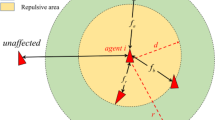Abstract
There are many interesting flocking phenomena in nature, such as joint predation and group migration, and the intrinsic communication patterns of flocking are essential for studying group behavior. Traditional models of communication such as the pigeon flock model and the wolf pack model define all agents within a perceptual distance as the neighborhoods, and some models have fixed communicating numbers. There is a significant impact on the quality of the flocking formation when encountering poor initial state of the flocking, multiple obstacles, or loss of certain agents. To solve this problem, this paper proposes a local communication model with nearest agents in four directions. Based on this model and behavioral method, two distributed flocking formation algorithms are designed in this paper for different scenarios, namely the flocking algorithm and the circular formation algorithm. Numerical simulation results show that the flocking can pass through the obstacle area and re-formation smoothly, and also the formation quality of the flocking is better compared with the traditional communication model.



















Similar content being viewed by others
Data Availability
No applicable.
References
Fan, X. M., Sayers, W., Zhang, S. J., Han, Z., Ren, L. Q., & Chizari, H. (2020). Review and classification of bio-inspired algorithms and their applications. Journal of Bionic Engineering, 17, 611–631. https://doi.org/10.1007/s42235-020-0049-9
Vicsek, T., & Zafeiris, A. (2012). Collective motion. Physics Reports, 517, 71–140. https://doi.org/10.1016/j.physrep.2012.03.004
Wang, G.-G., Deb, S., & Cui, Z. H. (2019). Monarch butterfly optimization. Neural Computing and Applications, 31, 1995–2014. https://doi.org/10.1007/s00521-015-1923-y
Heidari, A. A., Mirjalili, S., Faris, H., Aljarah, I., Mafarja, M., & Chen, H. (2019). Harris hawks optimization: Algorithm and applications. Future Generation Computer Systems, 97, 849–872. https://doi.org/10.1016/j.future.2019.02.028
Wang, G.-G. (2018). Moth search algorithm: A bio-inspired metaheuristic algorithm for global optimization problems. Memetic Computing, 10, 151–164. https://doi.org/10.1007/s12293-016-0212-3
Wu, G. X., Xu, T. T., Sun, Y. S., & Zhang, J. W. (2022). Review of multiple unmanned surface vessels collaborative search and hunting based on swarm intelligence. International Journal of Advanced Robotic Systems. https://doi.org/10.1177/17298806221091885
Tahir, A., Böling, J., Haghbayan, M.-H., Toivonen, H. T., & Plosila, J. (2019). Swarms of unmanned aerial vehicles—a survey. Journal of Industrial Information Integration, 16, 100106. https://doi.org/10.1016/j.jii.2019.100106
Chung, S.-J., Paranjape, A. A., Dames, P., Shen, S., & Kumar, V. (2018). A survey on aerial swarm robotics. IEEE Transactions on Robotics, 34, 837–855. https://doi.org/10.1109/TRO.2018.2857475
Lu, Y. T., Ma, Y. F., Wang, J. Y., & Han, L. (2020). Task assignment of UAV swarm based on wolf pack algorithm. Applied Sciences, 10, 8335. https://doi.org/10.3390/app10238335
Reynolds, C. W. (1987). Flocks, herds and schools: A distributed behavioral model. Proceedings of the 14th Annual Conference on Computer Graphics and Interactive Techniques. https://doi.org/10.1145/37401.37406
Crowther, W. (2004). Rule-based guidance for flight vehicle flocking. Proceedings of the Institution of Mechanical Engineers Part G, 218, 111–124. https://doi.org/10.1243/0954410041322005
Olfati-Saber, R., Fax, J. A., & Murray, R. M. (2007). Consensus and cooperation in networked multi-agent systems. Proceedings of the IEEE, 95, 215–233. https://doi.org/10.1109/ACC.2003.1239709
Olfati-Saber, R., & Murray, R. M. (2004). Consensus problems in networks of agents with switching topology and time-delays. IEEE Transactions on Automatic Control, 49, 1520–1533. https://doi.org/10.1109/tac.2004.834113
Saber, R.O., & Murray, R.M. (2003). Consensus Protocols for networks of dynamic agents. In: Proceedings of the 2003 American Control Conference, Denver, United States, pp. 951–956. https://resolver.caltech.edu/CaltechAUTHORS:20170522-153018041
Virágh, C., Vásárhelyi, G., Tarcai, N., Szörényi, T., Somorjai, G., Nepusz, T., & Vicsek, T. (2014). Flocking algorithm for autonomous flying robots. Bioinspiration & Biomimetics, 9, 025012. https://doi.org/10.1088/1748-3182/9/2/025012
Vásárhelyi, G., Virágh, C., Somorjai, G., Nepusz, T., Eiben, A. E., & Vicsek, T. (2018). Optimized flocking of autonomous drones in confined environments. Science Robotics, 3, eaat3536. https://doi.org/10.1126/scirobotics.aat3536
**e, Z. P., Long, Y. L., & Cheng, H. (2019). Distributed adaptive formation control of a team of aerial robots in cluttered environments. International Conference on Intelligent Robotics and Applications. https://doi.org/10.1007/978-3-030-27535-8_49
Mehdifar, F., Bechlioulis, C. P., Hashemzadeh, F., & Baradarannia, M. (2020). Prescribed performance distance-based formation control of multi-agent systems. Automatica, 119, 109086. https://doi.org/10.1016/j.automatica.2020.109086
Shao, J. Y., **e, G. M., Yu, J. Z., & Wang, L. (2005). Leader-following formation control of multiple mobile robots. Proceedings of the 2005 IEEE International Symposium on Mediterrean Conference on Control and Automation Intelligent Control. https://doi.org/10.1109/.2005.1467118
Yan, X., Jiang, D., Miao, R., & Li, Y. (2021). Formation control and obstacle avoidance algorithm of a multi-USV system based on virtual structure and artificial potential field. Journal of Marine Science and Engineering, 9, 161. https://doi.org/10.3390/jmse9020161
Mulgaonkar, Y., Makineni, A., Guerrero-Bonilla, L., & Kumar, V. (2017). Robust aerial robot swarms without collision avoidance. IEEE Robotics and Automation Letters, 3, 596–603. https://doi.org/10.1109/LRA.2017.2775699
Huo, M., Duan, H., & Fan, Y. (2021). Pigeon-inspired circular formation control for multi-UAV system with limited target information. Guidance, Navigation and Control, 1, 2150004. https://doi.org/10.1142/S2737480721500047
Qiu, H., & Duan, H. (2017). Multiple UAV distributed close formation control based on in-flight leadership hierarchies of pigeon flocks. Aerospace Science and Technology, 70, 471–486. https://doi.org/10.1016/j.ast.2017.08.030
Acknowledgements
This work was supported by Jilin Province Development and Reform Commission under Grant [2020C018-2] and Jilin Province Key R&D Plan Project under Grant [20200401113GX].
Author information
Authors and Affiliations
Corresponding author
Ethics declarations
Conflict of Interest
The authors declare no known competing interest.
Additional information
Publisher's Note
Springer Nature remains neutral with regard to jurisdictional claims in published maps and institutional affiliations.
Rights and permissions
Springer Nature or its licensor (e.g. a society or other partner) holds exclusive rights to this article under a publishing agreement with the author(s) or other rightsholder(s); author self-archiving of the accepted manuscript version of this article is solely governed by the terms of such publishing agreement and applicable law.
About this article
Cite this article
Feng, Y., Dong, J., Wang, J. et al. Distributed Flocking Algorithm for Multi-UAV System Based on Behavior Method and Topological Communication. J Bionic Eng 20, 782–796 (2023). https://doi.org/10.1007/s42235-022-00287-w
Received:
Revised:
Accepted:
Published:
Issue Date:
DOI: https://doi.org/10.1007/s42235-022-00287-w




